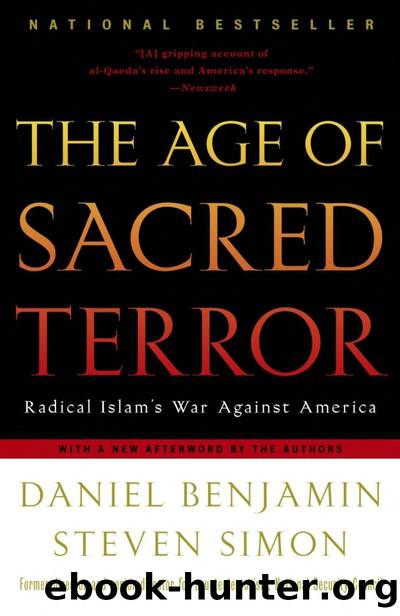The Age of Sacred Terror by Daniel Benjamin & Steven Simon

Author:Daniel Benjamin & Steven Simon [Benjamin, Daniel & Simon, Steven]
Language: eng
Format: epub
ISBN: 9781588362599
Google: IOoBZvdNrIkC
Publisher: Random House Publishing Group
Published: 2002-10-02T00:00:00+00:00
CHAPTER 7
THE UNKNOWN WAR
IN THE YEAR before America learned the name Usama bin Laden, the Saudi was a disturbing, enigmatic presence in the world of terrorism. In Washington, bin Ladenâs fingerprints could still not be discerned definitively on any significant act against the United States or American citizens, but there was growing alarm about al-Qaedaâs activities and the company it kept. Throughout, Iran remained the counterterrorism communityâs top concern; tracking Tehranâs undercover activities and jousting in the dark with the Iranian intelligence services occupied much of Washingtonâs energy. Yet, bin Laden was steadily becoming the subject of more scrutiny and apprehension. Around Christmas 1997, the White House decided that the threat posed by al-Qaeda had grown enough that it began pushing executive-branch agencies to increase their efforts to disrupt the network. Bin Ladenâs fatwa of February 1998, âJihad Against Jews and Crusaders,â a much briefer, more powerful statement than the one from 1996, caused an immediate stir when it was published in the London Arabic-language newspaper al-Quds al-Arabi. Its language was determined, direct, and redolent of the Quran. In the months that followed, bin Laden gave more interviews, and a recruitment video circulated around the Islamic world. Beginning in May, meetings were held at the White House on possible action that could be taken against the Saudi. But the obstacles were forbidding: at that point, the United States had no indictment of bin Laden and thus could not bring him to America for trial. No other country wanted custody of him. And there was nothing like a workable plan. At the same time, in the intelligence reporting, there were curious, coded statements that were ambiguous; it was impossible to know what, if anything, bin Laden was up to.
The answer came on August 7, 1998. The Situation Room staffâpeople detailed from the military and intelligence community, who route diplomatic cables, phone calls, and intelligence reports to White House officialsâroused the members of the Transnational Threats Directorate in the early morning with the news from East Africa. Gathered in a conference room in the West Wing basement, they went into permanent session with their colleagues from half a dozen different agencies to work out rescue coordination, an intelligence review, and defensive countermeasures. The initial crisis-management work lasted for several days, with staffers napping on couches when they could, or going home for short breaks.
But amid the nonstop information-gathering phone calls, cable writing, briefing of White House officials, and cajoling of other agencies to move faster, they could not stop glancing at the CNN images on the monitors: in the mountain of tangled rebar, concrete, and glass in downtown Nairobi, the staticky telephone reports of carnage in Dar es Salaam, and the seemingly endless procession of the injured, they saw something qualitatively different from anything that had gone before. No previous terrorist operation had shown the kind of skill that was evident in the destruction, within ten minutes, of two embassy buildings separated by hundreds of miles. Someone at the time was quoted
Download
This site does not store any files on its server. We only index and link to content provided by other sites. Please contact the content providers to delete copyright contents if any and email us, we'll remove relevant links or contents immediately.
Harry Potter and the Goblet Of Fire by J.K. Rowling(3261)
Never by Ken Follett(3094)
Unfinished: A Memoir by Priyanka Chopra Jonas(2990)
The Man Who Died Twice by Richard Osman(2465)
Machine Learning at Scale with H2O by Gregory Keys | David Whiting(2463)
Fairy Tale by Stephen King(2335)
Will by Will Smith(2210)
Rationality by Steven Pinker(1874)
The Storyteller by Dave Grohl(1776)
The Dawn of Everything: A New History of Humanity by David Graeber & David Wengrow(1703)
The Dark Hours by Michael Connelly(1691)
The Stranger in the Lifeboat by Mitch Albom(1647)
Cloud Cuckoo Land by Anthony Doerr(1572)
New Morning Mercies: A Daily Gospel Devotional by Paul David Tripp(1570)
Friends, Lovers, and the Big Terrible Thing by Matthew Perry(1523)
The Becoming by Nora Roberts(1453)
Can't Hurt Me: Master Your Mind and Defy the Odds - Clean Edition by David Goggins(1449)
The Strength In Our Scars by Bianca Sparacino(1442)
Einstein: His Life and Universe by Walter Isaacson(1441)
